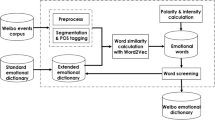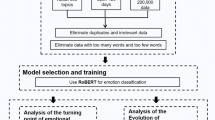Abstract
Taking advantage of social media platforms, such as Twitter, this paper provides an effective framework for emotion detection among those who are quarantined. Early detection of emotional feelings and their trends helps to implement timely intervention strategies. Given the limitations of medical diagnosis of early emotional change signs during the quarantine period, artificial intelligence (AI) models provide effective mechanisms in uncovering early signs, symptoms and escalating trends. Novelty of the approach presented herein is a multitask methodological framework of text data processing, implemented as a pipeline for meaningful emotion-semantic analysis and trend detection. Regarding the significant applications of this research work, the experimental results revealed that our AI-based emotion-semantic aspects can effectively uncover people’s emotional reactions during a pandemic, especially when abiding to the stay-at-home preventive measure. Moreover, the research can be applied to uncover reactions to similar public health policies that affect people’s well-being.




Similar content being viewed by others
Change history
01 February 2024
A Correction to this paper has been published: https://doi.org/10.1007/s12652-023-04741-3
References
Aslam F, Awan TM, Syed JH, Kashif A, Parveen M (2020) Sentiments and emotions evoked by news headlines of coronavirus disease (COVID-19) outbreak. Human Soc Sci Communi. https://doi.org/10.1057/s41599-020-0523-3
Becker M, Kasper S, Böckmann B, Jöckel K-H, Virchow I (2019) Natural language processing of German clinical colorectal cancer notes for guideline-based treatment evaluation. Int J Med Inform 127:141–146
Blei DM, Ng AY, Jordan MI (2003) Latent Dirichlet allocation. J Mach Learn Res 3(Jan):993–1022
Castiglione A, Umer M, Sadiq S, Obaidat MS, Vijayakumar P (2021) The role of internet of things to control the outbreak of COVID-19 pandemic. IEEE Internet Things J 8(21):16072–16082
Castiglione A, Vijayakumar P, Nappi M, Sadiq S, Umer M (2021) COVID-19: automatic detection of the novel coronavirus disease from CT images using an optimized convolutional neural network. IEEE Trans Ind Inform 17(9):6480–6488
Cauberghe V, Van Wesenbeeck I, De Jans S, Hudders L, Ponnet K (2021) How adolescents use social media to cope with feelings of loneliness and anxiety during COVID-19 lockdown. Cyberpsychol Behav Soc Netw 24(4):250–257
de Las Heras-Pedrosa C, Sánchez-Núñez P, Peláez JI (2020) Sentiment analysis and emotion understanding during the COVID-19 pandemic in Spain and its impact on digital ecosystems. Int J Environ Res Public Health 17(15):5542
Ekman P et al (1999) Basic emotions. Handb Cognit Emotion 98(45–60):16
Gautam R, Sharma M (2020) Prevalence and diagnosis of neurological disorders using different deep learning techniques: a meta-analysis. J Med Syst 44(2):49
Hasan M, Rundensteiner E, Agu E (2019) Automatic emotion detection in text streams by analyzing twitter data. Int J Data Sci Anal 7:35–51
Hochreiter S, Schmidhuber J (1997) Long short-term memory. Neural Comput 9(8):1735–1780 (Search in)
Hofmann T (2001) Unsupervised learning by probabilistic latent semantic analysis. Mach Learn 42:177–196
Jelodar H, Wang Y, Orji R, Huang S (2020) Deep sentiment classification and topic discovery on novel coronavirus or COVID-19 online discussions: NLP using LSTM recurrent neural network approach. IEEE J Biomed Health Inform 24(10):2733–2742
Johnsen J-AK, Eggesvik TB, Rørvik TH, Hanssen MW, Wynn R, Kummervold PE (2019) Differences in emotional and pain-related language in tweets about dentists and medical doctors: text analysis of twitter content. JMIR Public Health Surveill 5(1):e10432
Kabir MY, Madria S (2021) EMOCOV: machine learning for emotion detection, analysis and visualization using COVID-19 tweets. Online Soc Netw Media 23:100135
Khanpour H, Caragea C (2018) Fine-grained emotion detection in health-related online posts. In: Proceedings of the 2018 conference on empirical methods in natural language processing, pp 1160–1166
Kim Y (2014) Convolutional neural networks for sentence classification. arXiv preprint arXiv:1408.5882
Kim J-C, Chung K (2020) Discovery of knowledge of associative relations using opinion mining based on a health platform. Pers Ubiquitous Comput 24:583–593
Kwon S et al (2021) MLT-DNet: speech emotion recognition using 1D dilated CNN based on multi-learning trick approach. Expert Syst Appl 167:114177
Lee RY, Brumback LC, Lober WB, Sibley J, Nielsen EL, Treece PD, Kross EK, Loggers ET, Fausto JA, Lindvall C et al (2021) Identifying goals of care conversations in the electronic health record using natural language processing and machine learning. J Pain Symp Manag 61(1):136–142
Li H, Hua X (2020) Deep reinforcement learning for robust emotional classification in facial expression recognition. Knowl Based Syst 204:106172
Li Q, Wei C, Dang J, Cao L, Liu L (2020) Tracking and analyzing public emotion evolutions during COVID-19: a case study from the event-driven perspective on microblogs. Int J Environ Res Public Health 17(18):6888
Mohammad SM, Kiritchenko S, Zhu X (2013) NRC-Canada: building the state-of-the-art in sentiment analysis of tweets. arXiv preprint arXiv:1308.6242
Ong DC, Wu Z, Tan Z-X, Reddan M, Kahhale I, Mattek A, Zaki J (2019) Modeling emotion in complex stories: the Stanford emotional narratives dataset. IEEE Trans Affect Comput 12(3):579–594
Peng W, Li X, Shen S, He D (2020) Social media opinion summarization using emotion cognition and convolutional neural networks. Int J Inf Manag 51:101978
Plaza-Del-Arco FM, Martín-Valdivia MT, Urena-Lopez LA, Mitkov R (2020) Improved emotion recognition in Spanish social media through incorporation of lexical knowledge. Future Gener Comput Syst 110:1000–1008
Robert P (1980) A general psychoevolutionary theory of emotion. Theories of emotion. Elsevier, Amsterdam, pp 3–33
Sun X, Song Y, Wang M (2020) Toward sensing emotions with deep visual analysis: a long-term psychological modeling approach. IEEE MultiMedia 27(4):18–27
Uddin MZ, Nilsson EG (2020) Emotion recognition using speech and neural structured learning to facilitate edge intelligence. Eng Appl Artif Intell 94:103775
Umer M, Sadiq S, Ahmad M, Ullah S, Choi GS, Mehmood A (2020) A novel stacked CNN for malarial parasite detection in thin blood smear images. IEEE Access 8:93782–93792
Venigalla ASM, Chimalakonda S, Vagavolu D (2020) Mood of India during COVID-19—an interactive web portal based on emotion analysis of twitter data. In: Conference companion publication of the 2020 on computer supported cooperative work and social computing, pp 65–68
Wechsler H (2023) Immunity and security using holism, ambient intelligence, triangulation, and stigmergy: sensitivity analysis confronts fake news and covid-19 using open set transduction. J Ambient Intell Human Comput 14(4):3057–3074
WHO (2020) Organization, W.H. coronavirus disease pandemic. https://www.who.int
Yousaf A, Umer M, Sadiq S, Ullah S, Mirjalili S, Rupapara V, Nappi M (2020) Emotion recognition by textual tweets classification using voting classifier (LR-SGD). IEEE Access 9:6286–6295
Yu S, Zhu H, Jiang S, Chen H (2014) Emoticon analysis for Chinese health and fitness topics. In: Smart health: international conference, ICSH 2014, Beijing, China, July 10–11, 2014. Proceedings, Springer. pp 1–12
Acknowledgements
We acknowledge that already a preprint of this manuscript has been uploaded to arXiv (http://arxiv.org/abs/2101.06484), medrxiv (https://doi.org/10.1101/2021.01.16.21249943).
Author information
Authors and Affiliations
Corresponding author
Additional information
Publisher's Note
Springer Nature remains neutral with regard to jurisdictional claims in published maps and institutional affiliations.
Rights and permissions
Springer Nature or its licensor (e.g. a society or other partner) holds exclusive rights to this article under a publishing agreement with the author(s) or other rightsholder(s); author self-archiving of the accepted manuscript version of this article is solely governed by the terms of such publishing agreement and applicable law.
About this article
Cite this article
Jelodar, H., Orji, R., Matween, S. et al. Emotion detection and semantic trends during COVID-19 social isolation using artificial intelligence techniques. J Ambient Intell Human Comput 14, 16985–16993 (2023). https://doi.org/10.1007/s12652-023-04712-8
Received:
Accepted:
Published:
Issue Date:
DOI: https://doi.org/10.1007/s12652-023-04712-8




